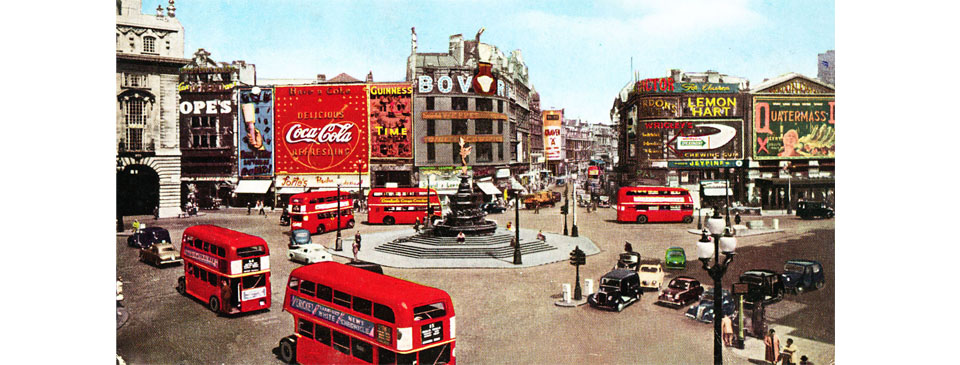In brief – Late-20th century London

Traffic flows around the Shaftesbury Memorial fountain at Piccadilly Circus in about 1955. The Bovril and Guinness advertisements had been in place for several decades when they were joined by Coca Cola shortly before this photo was taken. The film Quatermass Experiment is showing at the London Pavilion cinema.
In the second half of the 20th century there was a major change in the demographics of London. Within a space of twenty years Britain, and particularly London, underwent its biggest cultural change since the Norman conquest. As native Londoners began to move out to the new towns after the Second World War there was a labour-shortage in the capital. It found itself in need of new workers and small numbers of men from the former British colonies in the West Indies were invited to fill these gaps. The numbers arriving in London remained relatively small at first but quickly accelerated each year, helped partly by recruitment campaigns in the Caribbean by London Transport and the National Health Service.
Political instability, natural disasters and poor economies in some of the other former colonies such as Malta, Cyprus and Pakistan brought people from those countries to London. In the 1950s Chinese immigrants from Hong Kong began to arrive. Political problems in Africa, from where ethnic-Indians were being expelled, brought a wave of migrants in the 70s. Many of these newcomers settled in particular areas. West Indians initially found cheap accommodation in Brixton and Notting Hill; Chinese opened restaurants in Soho; Indians formed a community around Southall; Cypriots grouped together in Harringay; and Bangla-Deshis took over the former Jewish garment trade around Whitechapel.
In 1962 the Government ended the right of Commonwealth citizens to migrate to the UK. Yet as one door closed others opened. New international treaties gave asylum in politically unstable countries to those fleeing wars and persecution around the world, such as Vietnam, Somalia, Yugoslavia, Afghanistan and the Middle East. The oil crisis of 1973 brought many Arabs to London, settling around Bayswater and Earls Court. In the 1970s Britain joined the European Union, which allowed for free movement of EU citizens.
As continuing waves of new immigrants arrived in Britain during the 1950s and 60s, and particularly London, there was a growing antagonism towards them from some of the existing white population. A new far-right political party, the National Front, succeeded the pre-war British Union of Fascists. It had much the same agenda as its predecessor but without the uniforms; and with their actions directed against West Indians and Asians instead of Jews. Antagonism towards the immigrant population could not be categorized as just right-wing. It was a sentiment shared by many in London, particularly amongst the white working class, most of whom were lifelong Labour voters. The National Front was actively opposed by the Anti-Nazi League and the Socialist Workers Party. Whenever the NF held a march or demonstration the ANL held a counter-protest, with frequent violent clashes.
In August 1958 a group of white youths went ‘nigger-hunting’ around Shepherd’s Bush and Notting Hill. The following weekend a crowd of about 400 whites began attacking houses occupied by West Indians around Notting Dale, breaking windows and setting one property alight. That brought thousands of people of all colours onto the streets and violence continued for the following week. One hundred and forty people were arrested, including black people defending themselves and white people who had attempted to help them. The incident left West Indians with a mistrust of the police for years after. The largest disturbance of the century in London took place at Brixton in April 1981, starting after a crowd wrongly assumed a policeman had attacked a black youth. Over 300 were injured in fighting, over 100 vehicles damaged or destroyed, and almost 150 buildings damaged. A second riot took place there in September 1985.
The Trinidadians who settled at Notting Hill brought with them their culture of steel bands and carnival, evolving from the 1960s into the Notting Hill Carnival. The parade around the area of Ladbroke Grove and Westbourne Grove each August Bank Holiday, joined by numerous West Indian sound systems, grew into one of London’s major annual events.
